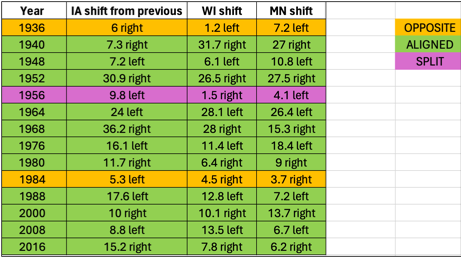Iowa Portends an Upper Midwest Blowout for Trump - 92 Years of History Dissected
Topic: Elections
Yesterday, I posted about a new poll showing President Trump with a commanding 18-point lead in a three-man race between himself, Joe Biden, and Robert F. Kennedy.
This is the gold standard poll for Iowa, and it had Trump +8 in the 2020 race just before Election Day.
Trump +18.
Spells doom for Democrats in Wisconsin and will require video game level fraud in the Twin Cities to hold Minnesota.
You can find online commentary about Selzer and Co.’s 2020 poll here (correction, the poll only had Trump +7, not +8 as I mentioned in my social media post yesterday). Trump wound up carrying the Hawkeye State by 8.2%, or 138,611 votes, in 2020’s certified results, though I think they are slightly shorted to sell the steal in Wisconsin, Pennsylvania, Michigan, and even Minnesota. You can read my full 2020 review/2024 assessment of Iowa here. In that assessment, I have Iowa going to Trump by a minimum of 12% this year, and hypothetically by more than 15% in an election free of widespread cheating, which is generally carried out by use of corrupt electronic voting systems, mail-in balloting fraud, and ballot harvesting.
Last week’s polling from Selzer and Co., widely considered the gold standard for Iowa polling, tells me I may not be insane after all. If you’ve read this journal for some time, you understand by now that presidential elections work like the switch of a light dimmer. The harder you slide it one way, the more intense the lights all throughout the room become, and vice versa. The harder right a presidential environment moves, with few exceptions, the more to the right the map will move, especially when we are talking about regional earthquakes like a Trump +18 poll from the most reliable pollster in a state, in a state that Barack Obama carried twice! Yes, you read that right - Obama carried Iowa by 5.8% over a milquetoast moderate Republican nominee just 12 short years ago. If you’re a Trump diehard, that should show you just how far he has come, that we are not scrutinizing the electoral map figuring out how to trip up Iowa by less than a point, which is all George W. Bush could handle in a 2004 reelection campaign.
Regions move together. Iowa, Wisconsin, and Minnesota make up a region I refer to as the Upper Midwest. The voting populations differ from their counterparts in the Industrial Midwest, also referred to as the Rust Belt (not a flattering term), which stretches from Upstate New York through Pennsylvania, Ohio, Michigan, Indiana, and southern Illinois. Voters in the Upper Midwest are strangely moderate and more swayed by agriculture policy (read up on Iowa’s strange shifting in the 1980s amid a sea of Republican landslides), though certain parts of the state resemble union-dominated counties in the latter region. The Upper Midwest had much larger third-party vote shares in 2016, which redistributed itself in stranger ways in the 2020 race, widely perceived as a traditional two-man contest without a well-known third party upstart like Gary Johnson or dissident like Jill Stein. Therefore, when analyzing the two regions, I tend to not stuff Wisconsin into the same box as Pennsylvania and Michigan, which are political cousins with nearly identical tendencies going back to 1948.
Selzer has Trump 11 points ahead of his polling from the November 2020 election, when she hit within 1.2% of the certified margin, well within her margin of error. Let’s split the difference and round down, and say Trump is due for a 5% improvement in Iowa, meaning he would win the state by a certified margin north of 13 points, matching my prediction with razor precision.
What would modern electoral history suggest for Wisconsin and Minnesota if Trump shifts Iowa five points right? Remember, it’s not just Selzer’s polling and a read on trending that informs my prediction, but also voter registration by party. Wisconsin and Minnesota do not register voters by party, but Iowa does, and the correlation between the states is strong, as you will read in the balance of this article. Iowa has zoomed from a R+1.0% advantage to R+9.8%, and climbing, an astonishing shift that is likely to make it nearly impossible to rip off Wisconsin and will require an Olympic performance in election fraud to hold down Minnesota, which hasn’t been carried by a GOP presidential nominee since Richard Nixon grabbed it by 5.5% in 1972.
Here is my scoreboard, with 22 elections having passed since the 1932 election (beginning of New Deal politics and subsequent regional impact):
In 16 of 22 elections (72.7%), Wisconsin and Minnesota have followed in the same direction as Iowa - right or left.
In 4 of 22 elections (18.2%), Wisconsin and Minnesota moved in the opposite direction of Iowa.
In 1 of 22 elections each (9.0% combined), one of Wisconsin or Minnesota moved with Iowa - right or left.
Moving into very recent times, since 1996:
In 6 of 7 elections (85.7%), Wisconsin and Minnesota have followed in the same direction as Iowa - right or left. The only exception was in 2004, when Iowa narrowly moved right (by 1.0%), tipping to George W. Bush, while Wisconsin went left by 0.2% and Minnesota left by 1.1%. There are many theories as to “why,” which Richard Baris expertly dissects down to the sentiments of various white ethnicities regarding the Iraq War.
History Lesson on Movement of Iowa
For this study, I’ve isolated all elections since 1932 in which Iowa has moved more than 5 points to the left or right from the previous. That removes eight elections (1944, 1960, 1972, 1992, 1996, 2004, 2012, 2020) from consideration. Additionally, I have thrown out 1952, 1964, and 1968, because they aligned with national realignments or landslides and have shifts for Iowa that are not realistic for this year, which skew the measurements I’m seeking (30.9%, 24.0%, 36.2%), given that I’m trying to figure out just how much momentum we can expect in Wisconsin and Minnesota if Iowa moves five points right, let alone ten or more.
Out of the 11 remaining in the sample, the 1936 and 1984 elections had dual opposing trends, in which Iowa ran 6 points right in 1936, but Wisconsin (1.2% left) and Minnesota (7.2% left) went in the opposite direction in cooling off from Roosevelt’s 1932 blowout of Herbert Hoover; in 1984, thanks to the farm crisis, Iowa was less bullish on Ronald Reagan, moving 5.3% left, but less-impacted Wisconsin and Minnesota went 4.5 and 3.7 point right, respectively. In 1956, Minnesota (4.1% left) followed Iowa (9.8%) left in Eisenhower’s reelection campaign, with Wisconsin inching 1.5% right in a split decision.
The remaining 8 elections in the study (72.7% of the sample) have Iowa, Wisconsin, and Minnesota moving in the same direction when the shift in Iowa is five points or more, in either direction.
The last four shifts of five points or more have aligned with the corresponding movement in Wisconsin and Minnesota.
Four left shifts of 5.0 or more:
Average shift in Iowa = 12.4%
Average shift in Wisconsin = 11.1%
Average shift in Minnesota = 10.8%
-
Four right shifts of 5.0 or more
Average shift in Iowa = 11.1%
Average shift in Wisconsin = 14.0%
Average shift in Minnesota = 14.0%
-
Last four aligning shifts of 5.0% or more (1988, 2000, 2008, 2016)
Average shift in Iowa = 12.9%
Average shift in Wisconsin = 11.1%
Average shift in Minnesota = 8.5%
Conclusion
There is extremely close correlation between Iowa and the two other Upper Midwestern States, Wisconsin and Minnesota. Since 1964, all shifts of 5.0% or more in Iowa have been reflected in the other two states except for in 1984, when the farm crisis hurt Reagan in Iowa, which had the second biggest swing toward Mondale after only North Dakota. The extremely critical southwestern portion of Wisconsin corresponds politically with many old-school Democrat counties found in eastern Iowa, all of which have a Republican-favorable registration shift underway since the 2020 election. Outside of the Twin Cities, which dominate Minnesota’s electoral landscape, similar counties proliferate the state.
Keep in mind, it’s looking much more likely a 10-point shift in Iowa is underway, similar to what has occurred in Missouri since 2008, when Obama nearly won it against John McCain, rather than the 5-point shift I’m assessing here. I have Wisconsin comfortably in the Trump camp in a fair 2020 election, and Minnesota right on the fringe (Trump wouldn’t have campaigned there, in a state he didn’t need, if he didn’t believe he should have won it, or at least been inside of the loony 7.2% certified margin of the state when he finished just 1.5% out in 2016).
Here is how far Wisconsin and Minnesota have been from Iowa since 1960:
1960
WI 9.8%, MN 12.1%
-
1964
WI 0.4%, MN 3.8%
-
1968
WI 8.6%, MN 0.3%
-
1972
WI 7.4%, MN 11.6%
-
1976
WI 0.7%, MN 11.9%
-
1980
WI 8.0%, MN 8.8%
-
1984
WI 1.8%, MN 7.6%
-
1988
WI 6.6%, MN 3.2%
-
1992
WI 1.6%, MN 5.6%
-
1996
WI 0.0%, MN 5.8%
-
2000
WI 0.1%, MN 2.7%
-
2004
WI 1.1%, MN 4.2%
-
2008
WI 4.4%, MN 0.7%
-
2012
WI 1.2%, MN 1.9%
-
2016
WI 8.6%, MN 10.9%
-
2020
WI 8.8%, MN 15.3%
Wisconsin averages 4.3% from Iowa since 1960, with a maximum distance of 9.8% (1960). Minnesota averages 6.7% from Iowa since 1960, with a maximum distance of 15.3% (2020), with the latter outcome coming in a highly corrupt quasi-election.
Bottom Line
If Trump wins Iowa by 13% (five points more than he did in certified 2020 results), he would clear the maximum (since 1960) Wisconsin gap by 3.2%, and its average by 8.7%. In the case of Minnesota, he would clear the average distance by 6.3%, eclipse the massive gap in 2016 by 2.1%, and come close to the bloated 2020 gap. Given that Minnesota’s Democrat trifecta has mastered cheating and enshrined it into law, it will take a win of Selzer’s predicted margins to even have a chance to upend the most loyal Democrat state.
These numbers suggest Wisconsin is Trump’s for the taking, even if it makes the smallest reflecting move (7.8%) since 1988. That would give Trump a win of more than 7% in certified results. Minnesota will likely be within 3 points even with the mecca to election fraud that has been erected in St. Paul.
Seth Keshel, MBA, is a former Army Captain of Military Intelligence and Afghanistan veteran. His analytical method of election forecasting and analytics is known worldwide, and he has been commended by President Donald J. Trump for his work in the field.






What an extensive and thorough analysis ( what you are known for) that is perfect for any honest reader.
Iowa seems to be a sort of bellwether state for that region. I have always considered Illinois to be Upper Midwest, not part of the NE "rust belt". Downstate Illinois is largely rural and agricultural, as is my county. Southern Illinois is considered to be that southernmost tip next to KY and TN generally from a line east from St Louis, to the south, part of the Mid South.
Iowa, Illinois and Indiana have farming in common, and we all think similarly about politics.